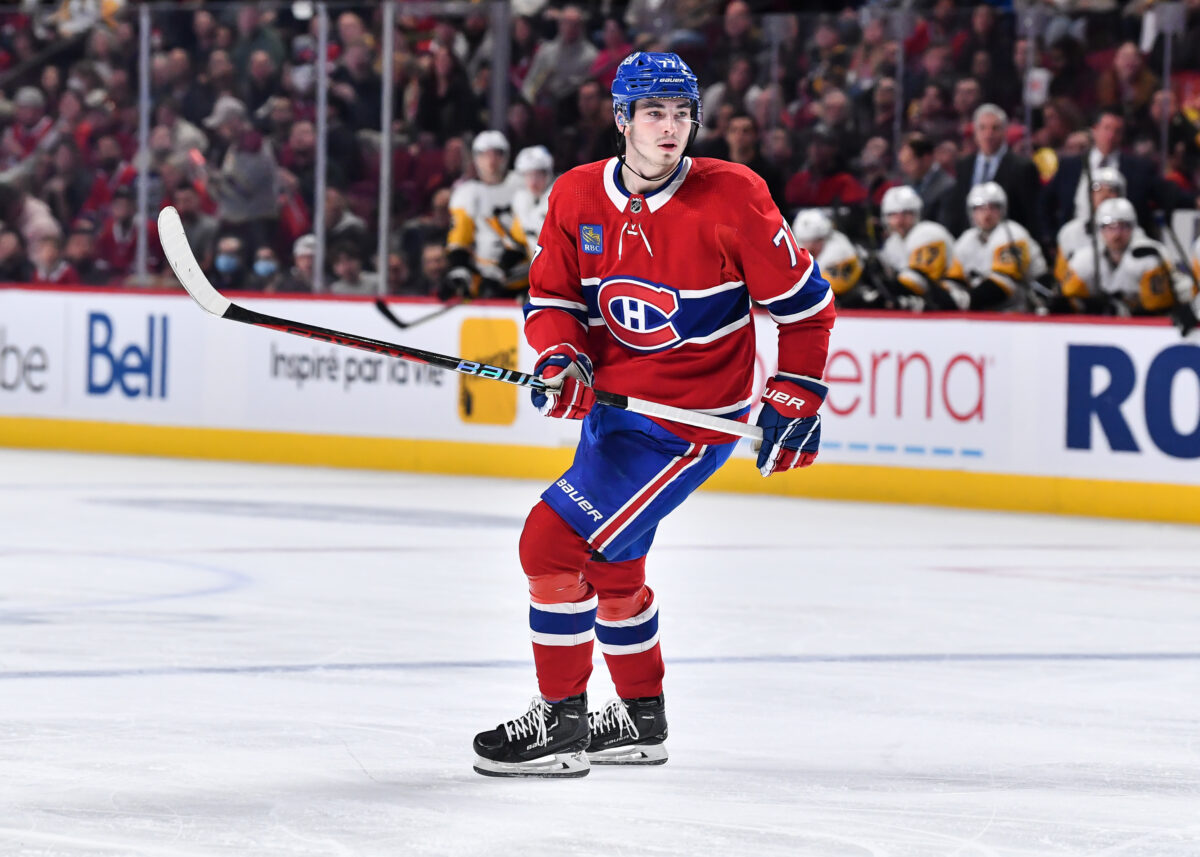Montreal Canadiens general manager (GM) Kent Hughes has been hard at work in this rebuild. He hasn’t just been adding draft picks via trade, but he’s also been rebuilding entire departments.
Related: Hockey Documentaries to Watch Right Now
One area that he has focused on has been to add significantly to the Canadiens’ center depth. This has been a weakness for the Habs for many years, but it looks as though there is hope for the future. He has drafted well by adding a potential middle-six center in Owen Beck; Hughes’ focus on building the development group should help centers drafted under the last regime. But it is via trade that the GM has made the biggest impact on this issue.
Canadiens’ Center Depth
In 2019, the Canadiens chose to draft a sniper at 15th overall in Cole Caufield, arguably the best goal scorer in his draft class. While the fan base universally seems content with that decision, they all wish for more centers. Now, imagine being a fan sitting in the Rogers Arena in Vancouver, watching the NHL Entry Draft unfold and hearing NHL Commissioner Gary Bettman announce not one, but two trades. The Canadiens acquire the third overall and 16th overall picks. The fans would have leaped for joy. What would that have cost them? Likely some top prospects, several picks maybe, and even a popular roster player or two.
However, Habs fans don’t need to imagine this. Hughes has essentially made this a reality, as he has added Kirby Dach and Alex Newhook, the players selected at those positions in 2019. It is safe to say it would have cost them far more than what was paid by Hughes. Now, five years later, the Habs will start the season with all three 2019 picks in their lineup.

This adds two natural centers to the depth chart. They join Nick Suzuki, Christian Dvorak, Jake Evans, and Sean Monahan as natural centers that will be competing for those four coveted positions. Evans is ideal as a fourth-line center, and Suzuki’s play over the last three seasons has proven that he has the top spot locked up. This leaves the middle six center positions up for grabs.
On the second line, Dach, Monahan, and Newhook could battle it out. Dach has shown that he can play the wing on the top unit, and his style of play can elevate Suzuki and Caufield’s play to the next level. However, his size, reach, and ability to generate controlled zone exits on defense and controlled zone entries offensively make him an excellent choice to play at center. While he needs help to improve in the faceoff circle, having only won 38.3 percent of his faceoffs last season, he excels in every other aspect a coach would want from a top-six center. This leaves one center position available: the third line.
Canadiens Third Center
Monahan and Newhook might be seen as third-line centers in this lineup by some. However, Monahan’s hip issues would mean that he would be better off health-wise taking face-offs, then shifting over to the wing as play begins.
Newhook’s offensive potential would mean he is likely to start the season in a top-six role on the wing, even if he has a better faceoff rate than Dach. Being 5-foot-10, he is undersized by NHL standards, especially at center. His strength is speed, and his playmaking vision, which could make him an ideal winger in the Canadiens’ offensive scheme, which relies heavily on that speed in transition to generate scoring chances. This leaves Dvorak.
Canadiens Need Dvorak
Dvorak is a serviceable middle-six center best suited for a third-line role on a playoff team. The 27-year-old is entering the fifth year of a six-year contract that expires in 2025 and pays him $4.45 million per season, with a modified no-trade clause (eight-team no-trade list). Dvorak suffered a season-ending knee injury in 2022-23, and while he is expected to be ready for the start of the 2023-24 season, there is always a possibility he will miss a segment of the training camp.
Recently, there has been some trade talk surrounding Dvorak. On 32 Thoughts: The Podcast, Elliotte Friedman said: “We should mention with Montreal, Christian Dvorak, it would seem that there isn’t a role for him there now they got so many centers, so I think that’s another name worth keeping an eye on”.
On paper, that does seem to be true, but there are many reasons why that is not the case. Most were mentioned above, but there are other reasons. Dvorak is one of the veterans who head coach Martin St. Louis relies upon most, especially defensively. With Suzuki playing an average of over 21 minutes per game in all situations, Dvorak’s role in alleviating Suzuki’s defensive responsibilities will be essential in allowing the team captain to focus more on playing an offensive role.

While Dvorak is not an essential piece for Montreal, especially in the long term, he does have the ability to help stabilize the roster and provide the depth support a young team needs. There is another reason why he should play that role: trade value. As of right now, his trade value may not be seen as very high. It’s not the expectation that Dvorak changes addresses before the trade deadline. First, as mentioned, he is still injured. Second, neither Suzuki, Dach, nor Newhook are close to being above 50 percent in faceoffs over their young NHL careers.
But with a return to health leading to a strong season up to the trade deadline, that can change dramatically. Offensively, Dvorak is at a career average of 0.49 points per game, and he does play a solid defensive game. He is also a quiet, businesslike type of personality, known more as a quiet type who fits well in any locker room. However, his biggest asset is his skill in the faceoff circle, as he has a career 52.4 percent win rate, by far the best of anyone not named Monahan. A contending team that is looking for a center to win faceoffs, play a reliable two-way game, and bring a personality that will not change the overall dynamic in the locker room.
Until then, the Canadiens can rely on a variety of centers, giving the coaching staff options that they can deploy based on the game situation, allowing them to be more adaptive and match up well with more teams. This option alone should lead to a large improvement in the team’s overall play and a higher final standing in the 2023-24 season. With the issues Montreal has had in finding quality up the middle, the team’s motto should read, “There are never too many centers.”
